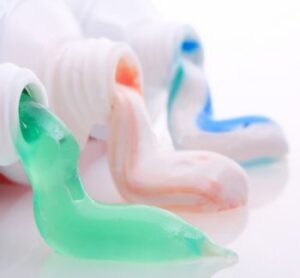Fluoride is a natural mineral that is found in water. The amount of fluoride in the water varies from area to area.
What are the benefits of fluoride?
Fluoride has been researched for over 50 years and water fluoridation has been proven to cut dental decay by 40 to 60%. Fluoride is present in many different natural sources, but can also be artificially added to our drinking water. A level of one part in a million has been shown to be most effective.
Fluoride can greatly help dental health by strengthening the tooth enamel, making it more resistant to tooth decay. Your local water supplier or health authority should be able to tell you how much fluoride is in the water in your area. One part of fluoride for every million parts of water (1ppm) is considered enough.
Is it in my water supply?
Possibly, depending on which area you live in! Your dentist or local council health officer should be able to tell you whether your water supply is fluoridated.
Are fluoride toothpastes enough?
Many toothpastes now contain fluoride, and brushing twice a day is how most people get their fluoride. From the age of 5, 1350-1500 ppm is recommended; check the tube as many children‟s toothpastes contain less.
Brushing should be supervised up to the age of 7, and children are encouraged to “spit, don‟t rinse”, so that fluoride stays on the teeth for a while, like a “renewal cream”. This is particularly effective at night, when saliva flow is reduced, as the fluoride can work for much of the night to repair early areas of decay.
Where else can I find fluoride?
Fluoride is also in salt and tea, and some countries artificially add fluoride to their table salt and milk.
Is fluoride safe?
Many reports have been published about the pros and cons of fluoride. After many years the scientific conclusion is that fluoride is of great benefit to dental health and helps to reduce decay, while causing no harmful side effects to general health.
How can I use fluoride to improve the dental health of my family?
Follow these simple steps: Use a fluoride toothpaste twice a day with 1350-1500 ppm (adult toothpaste) from the age of 5.
- Spit, don‟t rinse, think of the toothpaste as a night cream for teeth – regenerating and renewing tooth enamel!
- Bring your children to the dentist for a fluoride varnish application at least twice a year, more if the dentist recommends it.
- If you or your child is at higher risk of decay, e.g. during orthodontic treatment or because of excessive or frequent sugar consumption, consider a further supplement such as a mouthwash or high dose toothpaste. The dentist will suggest the correct formulation, as this is age dependent.
What are the side effects?
„Dental fluorosis‟ is a cosmetic problem which can occur when too much fluoride is taken when the teeth are forming (in the early years of life). This can happen for example when the water supply is already fluoridated and supplements such as drops or tablets are taken, or when children „eat‟ toothpaste. This can be avoided by supervising brushing up to the age of 7. We do not recommend tablets or drops and only a smear of toothpaste is required to protect teeth and to minimise the amount swallowed. Campaigners against fluoridation claim that an overdose of fluoride can sometimes cause „brittle bone‟ disease and digestive disorders, but these suggestions have not been scientifically proven, and if the recommendations above are followed, there is no reason to “overdose”.
In its mildest form, fluorosis appears as very fine pearly white lines or flecking on the surface of the teeth. This mild fluorosis is often undetectable except by a dental expert. Severe fluorosis may lead to pitting of the enamel and discoloration. However, severe fluorosis is rare in NZ. It is seen in other parts of the world.

